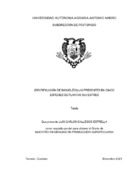Mostrar el registro sencillo del ítem
Identificación de biomoléculas presentes en cinco especies de plantas silvestres
| dc.contributor.advisor | Aguilera Carbó, Antonio Francisco | |
| dc.contributor.author | Gallegos Estrella, Luis Carlos | |
| dc.contributor.other | Sepúlveda Torre, Leonardo | |
| dc.contributor.other | Fuentes Lara, Laura Olivia | |
| dc.date.accessioned | 2022-03-15T20:17:26Z | |
| dc.date.available | 2022-03-15T20:17:26Z | |
| dc.date.issued | 2021-12-01 | |
| dc.identifier.uri | http://repositorio.uaaan.mx/xmlui/handle/123456789/48175 | |
| dc.description.abstract | "El objetivo de la presente investigación fue la identificación de biomoléculas de cinco tipos de plantas del semidesierto mexicano: árnica amarilla (Grindelia eligulata), árnica morada (Machaeranthera tanacetifolia), rosa de castilla (Rosa gallica), yerbanís (Tagetes lucida) y hierba de San Nicolás (Chrysactinia mexicana) con el fin de demostrar el potencial biológico de sus compuestos. Se utilizaron hojas, tallos y pétalos para realizar una extracción acuosa 1:5 m/v. Se evaluó la cinética de extracción de taninos hidrolizables y condensados, así como la cuantificación de fenoles totales mediante el método Folin-Ciocalteu. Los extractos acuosos fueron filtrados en membranas de # 1 para someterlos a una separación en columna de afinidad para posteriormente identificar sus moléculas mediante HPLC-Ms (cromatografía liquida de alta resolución). La actividad biológica se evidenció. Los resultados mostraron que los extractos de las plantas en cuestión contienen un alto potencial biológico y sus biomoléculas podrían ayudar al tratamiento de enfermedades causadas por el estrés oxidativo, por lo cual es importante el desarrollo de una estratega para su aplicación o experimentación in vivo, así como realizar pruebas de citotoxicidad para garantizar su uso en el tratamiento de enfermedades crónico-degenerativas" | es_MX |
| dc.format | es_MX | |
| dc.language | Español | es_MX |
| dc.publisher | Universidad Autónoma Agraria Antonio Narro | es_MX |
| dc.rights | Acceso Abierto | es_MX |
| dc.rights.uri | CC BY-NC-ND - Atribución-NoComercial-SinDerivadas | es_MX |
| dc.subject | CIENCIAS AGROPECUARIAS Y BIOTECNOLOGÍA | es_MX |
| dc.subject.other | Biomoléculas, Taninos, Actividad biológica, Citotoxicidad | es_MX |
| dc.title | Identificación de biomoléculas presentes en cinco especies de plantas silvestres | es_MX |
| dc.type | Tesis de maestría | es_MX |
| dc.description.abstractEn | "The objective of the present investigation was the identification of biomolecules of five types of plants of the Mexican semi-desert: yellow arnica (Grindelia eligulata), purple arnica (Machaeranthera tanacetifolia), rose of castile (Rosa gallica), yerbanís (Tagetes lucida) and grass of San Nicolás (Chrysactinia mexicana) in order to demonstrate the biological potential of its compounds. Leaves, stems and petals were used to perform a 1: 5 m / v aqueous extraction. The extraction kinetics of hydrolyzable and condensed tannins were evaluated, as well as the quantification of total phenols using the Folin-Ciocalteu method. The aqueous extracts were filtered on # 1 membranes to subject them to an affinity column separation to later identify their molecules by HPLC-Ms (high performance liquid chromatography). Biological activity was evidenced. The results show that the extracts of the plants in question contain a high biological potential and their biomolecules could help in the treatment of diseases caused by oxidative stress, which is why it is important to develop a strategy for their application or experimentation in vivo, as well. How to perform cytotoxicity tests to guarantee its use in the treatment of chronic degenerative diseases" | es_MX |
| dc.type.version | Versión publicada | es_MX |
| dc.audience | Estudiantes | es_MX |
| dc.audience | Investigadores | es_MX |
| dc.publisher.place | Torreón, Coahuila, México | es_MX |
